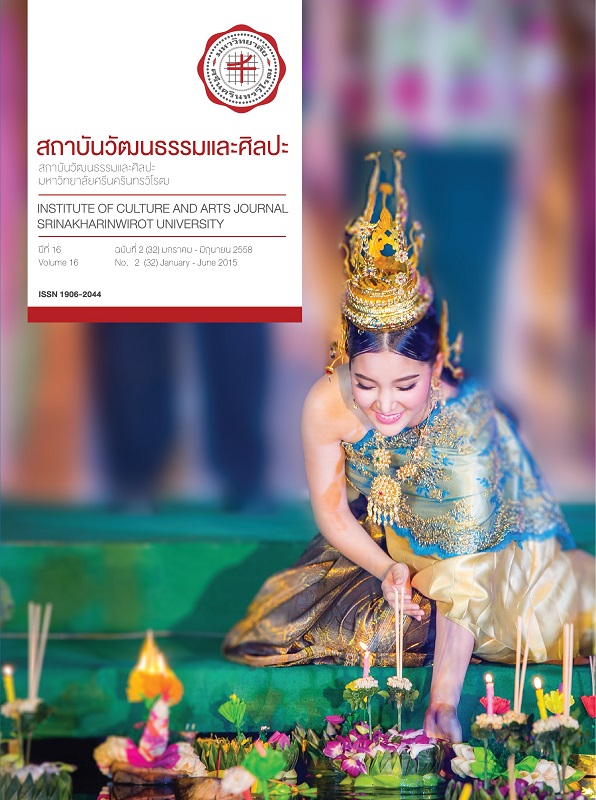วิวัฒนาการวัฒนธรรมการแสดงของคนไทยเชื้อสายมลายูในจังหวัดชายแดนภาคใต้ EVOLUTION OF THAI - MELAYU’S PERFORMANCES IN BORDER PROVINCES OF SOUTHERN THAILAND
บทคัดย่อ
บทคัดย่อ
วัฒนธรรมการแสดงจำเป็นต้องมีวิวัฒนาการเพื่อความคงอยู่ได้ในสังคมโดยเฉพาะการแสดงของคนไทยเชื้อสายมลายูที่มีจำนวนมากและหาชมได้ยากดังนั้น การศึกษาครั้งนี้มีวัตถุประสงค์คือ ศึกษาวิวัฒนาการวัฒนธรรมการแสดงของคนไทยเชื้อสายมลายูในจังหวัดชายแดนภาคใต้ 7 ชุด ได้แก่ มะโย่ง รองเง็ง รองเง็งตันหยง ซัมเปง ดาระ สิละ และดีเกร์ฮูลู โดยใช้ระเบียบวิจัยเชิงคุณภาพที่ใช้วิธีการแบบสำรวจ แบบสัมภาษณ์ แบบสังเกต การสนทนากลุ่ม ผลการวิจัยพบว่า การแสดงของคนไทยเชื้อสายมลายูมีวิวัฒนาการขึ้นอยู่กับการถ่ายทอด ดังนี้
1) หัวหน้าคณะเป็นผู้สอน ได้แก่ การแสดงรองเง็งตันหยง สิละ และดีเกร์ฮูลู ยังคงยึดรูปแบบการแสดงดั้งเดิม แต่มีพัฒนาเครื่องแต่งกายให้ประณีต และรูปแบบการแสดงที่น่าสนใจ มีการถ่ายทอดให้แก่เยาวชนจึงทำให้มีนักแสดงหลากวัย นอกจากนี้ยังมีการแสดงมะโย่งที่แบ่งออกเป็น (1) มะโย่งรูปแบบพิธีกรรมที่ยังคงแสดงโดยยึดรูปแบบดั้งเดิมจึงไม่มีวิวัฒนาการด้านใดเลย และ (2) มะโย่งรูปแบบความบันเทิง ที่ได้มีการนำการแสดงโนราเข้ามาใส่ในบางช่วงและเน้นความประณีตของการแต่งกาย แต่ทั้ง 2 รูปแบบนักแสดงยังคงเป็นผู้อาวุโส สังเกตได้ว่าผู้แสดงทั้ง 4 ชุด ยังคงเป็นเจ้าของวัฒนธรรม
2) ครูหรือรุ่นพี่เป็นผู้สอน ได้แก่ การแสดงรองเง็ง ซัมเปง และดาระ ซึ่งเป็นชุดการแสดงที่มีการถ่ายทอดในสถานศึกษา มีวิวัฒนาการรูปแบบการแสดงให้เข้ากับยุคสมัย เน้นความสวยงามของเครื่องแต่งกายทั้งคณะ ทั้งนี้นักแสดงส่วนใหญ่เป็นคนไทยพุทธ ยกเว้นการแสดงดาระที่มีเฉพาะพื้นที่ของคนไทยเชื้อสายมลายู
คำสำคัญ: …วิวัฒนาการวัฒนธรรมการแสดง, การแสดงของคนไทยเชื้อสายมลายูในจังหวัดชายแดนภาคใต้
Abstract
Cultural exhibitions, especially dying Thai-Melayu traditions, need to be developed if they are to stay relevant in society. This study aims to explore the evolution of Thai-Melayu performances in the border provinces in southern Thailand. They are categorized into seven forms: Mayong, Rong Ngeng, Rong Ngeng Tunyong, Sumpeng, Dara, Sila, Deekayhulu through a research methodology which utilized survey, interview, monitoring and group discussion methodologies. The result indicates that the development of the Thai-Melayu performance is mainly affected by the following factors:
1. Performances that the leader of the group is an instructor, such as Rong Ngeng Tunyong, Sila and Deekayhulu, continue to preserve the traditional form, albeit focusing on the innovation of costume and its appeal and impart to younger generations. Because of this reason, these performances always have performers of every age. Apart from that, Mayong can be categorized into two types 1. Ritual Mayong closely resemble the tradition without any development 2. Entertainment Mayong, which emphasizes the detail of costume and blends certain aspects of Nora into it. Both kinds are mainly performed by experienced performers. It is noticeable that these performers are natives of Thai-Melayu culture.
2. Performances in which the teacher or the senior is an instructor include: Rong Ngeng, Sumpeng and Dara – they are taught in education institutes. They keep developing through time and emphasize the beauty of the costume for the whole group. Most of the performers are Thai Buddhists except the Dara which only exist in Thai-Melayu areas.
Keywords: Culture Evolution of Performances, Thai - Melayu’s Performances in Border Provinces in Southern Thailand
Downloads
เผยแพร่แล้ว
How to Cite
ฉบับ
บท
License
บทความทุกบทความที่ได้รับการตีพิมพ์ถือเป็นลิขสิทธิ์ของวารสารสถาบันวัฒนธรรมและศิลปะ มหาวิทยาลัยศรีนครินทรวิโรฒ


